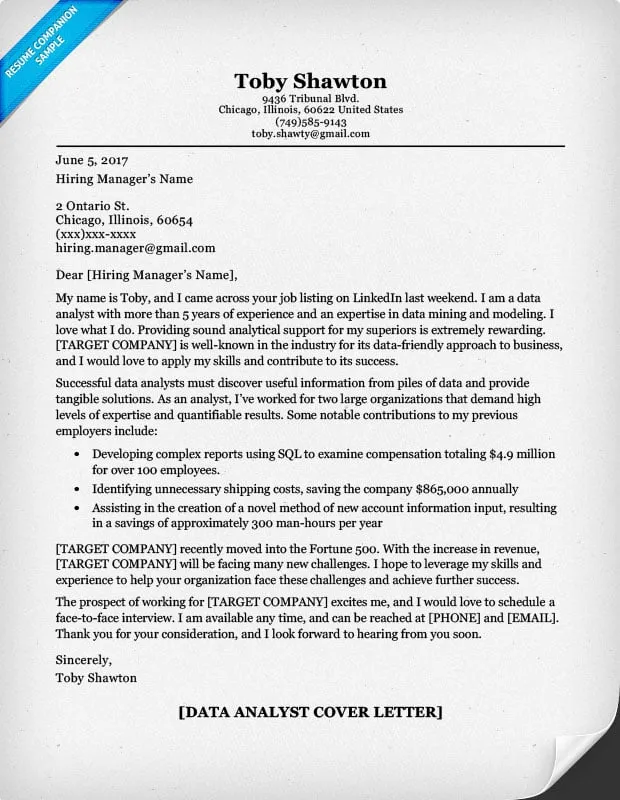Landing your first data analyst role can feel daunting, especially when crafting an entry-level cover letter. The cover letter is your first impression, a critical document that showcases your potential to prospective employers. To stand out from the crowd and make a positive impact, it is essential to focus on specific elements and present yourself in the best possible light. The following top 5 tips will guide you through crafting an exceptional cover letter that highlights your skills, accomplishments, and potential, increasing your chances of securing an interview and ultimately, your dream job as a data analyst.
Highlighting Your Skills
Your entry-level cover letter should immediately highlight the skills that make you a strong candidate. Even without extensive professional experience, you likely possess transferable skills from academic projects, internships, or personal endeavors. Focus on skills that are directly relevant to the data analyst role, such as data analysis, data visualization, statistical analysis, and programming languages like Python or R. If you have experience with data manipulation tools such as SQL or Excel, be sure to mention them. Ensure to mention any experience you have with relevant software or technologies. Avoid simply listing these skills; instead, briefly explain how you’ve used them to achieve a specific outcome.
Quantify Your Accomplishments
Quantifying your accomplishments is one of the most impactful ways to demonstrate your abilities. It moves beyond simply stating what you did and shows the results of your efforts. For instance, instead of saying “Analyzed data,” you can say “Analyzed sales data, identifying a 15% increase in customer retention by implementing a new segmentation strategy.” Use numbers, percentages, and specific metrics to showcase the impact of your work. This helps potential employers understand your ability to deliver tangible results, even in entry-level positions. This approach adds credibility and illustrates the value you can bring to the team, creating a compelling narrative that captures attention.
Showcase Relevant Projects
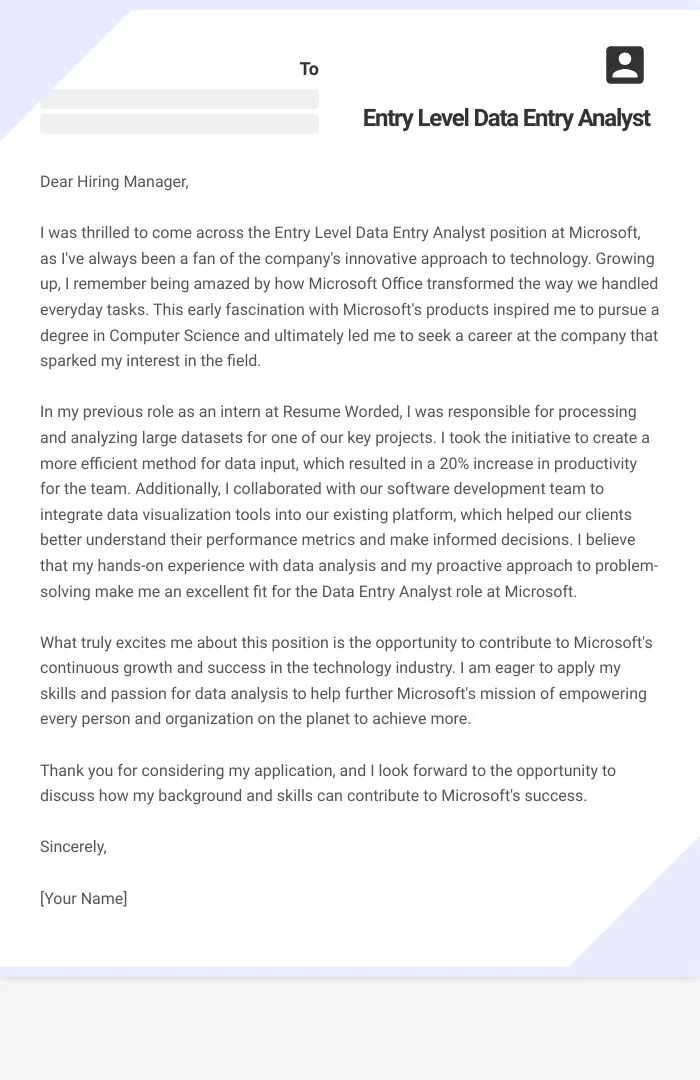
Since entry-level applicants often lack professional experience, showcasing relevant projects becomes incredibly important. These projects can include academic assignments, personal projects, or even volunteer work. Select projects that demonstrate your analytical skills, problem-solving abilities, and proficiency with data analysis tools. Briefly describe the project, your role, the methods you used, and the outcomes you achieved. If possible, include a link to a portfolio, a GitHub repository, or any other platform where you can showcase your work. This will allow the hiring manager to easily assess the quality and depth of your work and provide a tangible proof of your skills and experience.
Tailor to the Job Description
Generic cover letters are easily spotted and often disregarded. To make your cover letter stand out, tailor it to the specific job description and the company. Carefully review the job requirements and highlight the skills and experiences that align with their needs. Use keywords from the job description to demonstrate that you understand the role and the company’s priorities. Research the company and show that you understand their mission, values, and current projects. This demonstrates that you are genuinely interested in the position and have taken the time to understand what the company needs and expects from its employees.
Proofread Meticulously
Typos, grammatical errors, and formatting inconsistencies can quickly undermine your credibility. A cover letter with errors suggests a lack of attention to detail, a crucial skill for any data analyst. Proofread your cover letter multiple times and consider using grammar and spell-checking tools. It’s also a good idea to have someone else review your cover letter for errors and provide feedback. A polished, error-free cover letter reflects professionalism and attention to detail, making a positive first impression. Taking the time to proofread your cover letter can significantly increase your chances of getting an interview, so it is a very important step.
Formatting Your Cover Letter
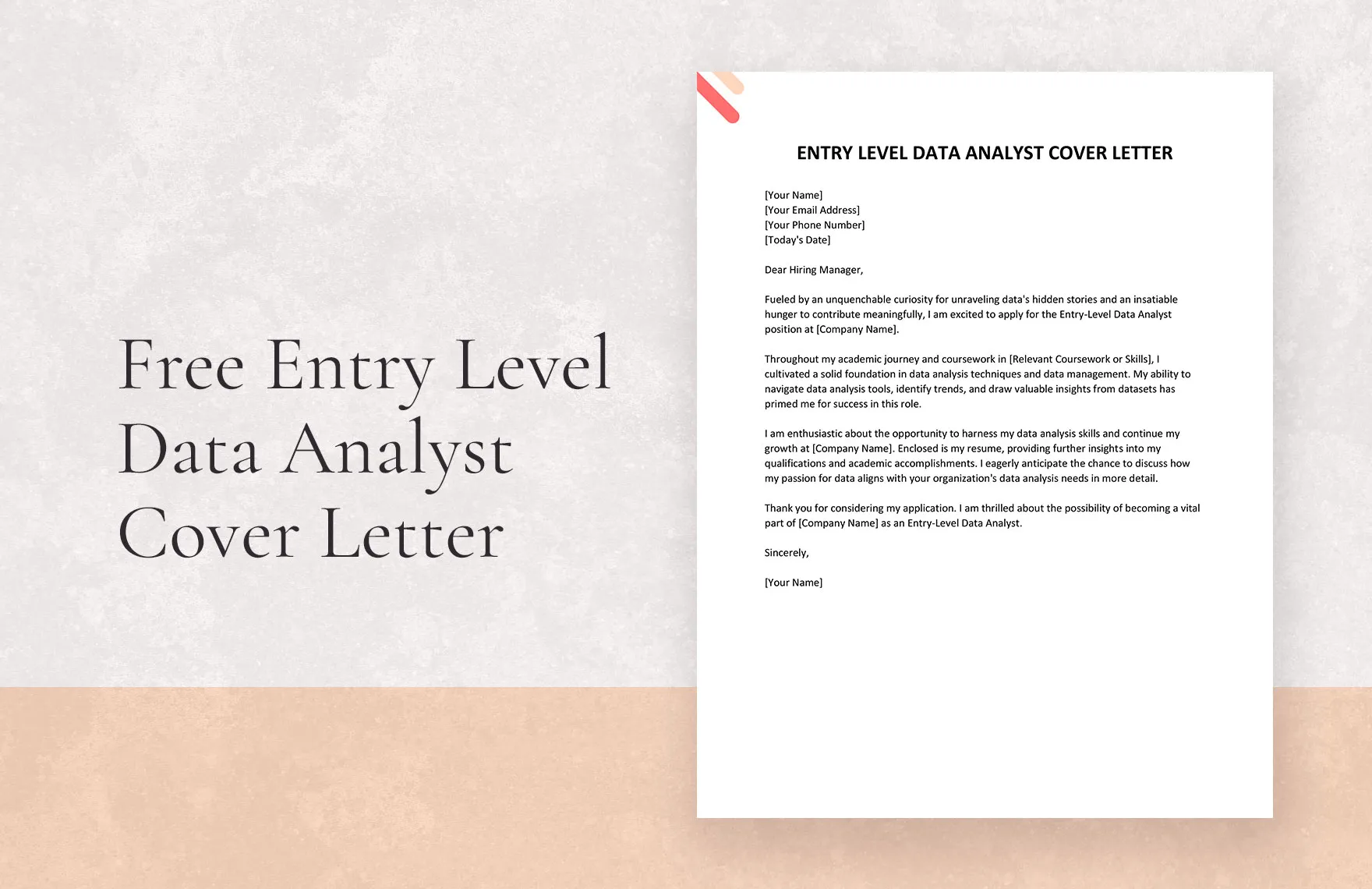
The format of your cover letter is just as important as its content. A well-formatted cover letter is easy to read and makes a professional impression. It should be visually appealing and easy to navigate. Use a clear and professional font, such as Arial or Times New Roman, and maintain consistent formatting throughout the document. Use clear headings and subheadings to organize your content and break up large blocks of text. Maintain a consistent margin size and spacing between paragraphs to enhance readability. A well-formatted cover letter demonstrates attention to detail, which is a critical skill for a data analyst. Also, use bullet points to list your skills, and accomplishments and to enhance readability.
Use a Professional Tone
Maintain a professional tone throughout your cover letter. Use formal language and avoid slang or overly casual expressions. Focus on showcasing your skills and experiences in a clear, concise, and confident manner. Avoid using jargon or technical terms that the reader might not understand. Be respectful and enthusiastic and express your genuine interest in the position and the company. A professional tone helps create a positive first impression and shows that you can communicate effectively in a professional environment.
Keep it Concise
Hiring managers are busy, so keep your cover letter concise and to the point. Aim for a length of one page, focusing on the most relevant information and avoiding unnecessary details. Each sentence should add value and serve a purpose. Your goal is to quickly capture the reader’s attention and convey why you are a great fit for the role. Eliminate unnecessary words and phrases, and use strong action verbs to make your letter more impactful. Being concise showcases your ability to communicate effectively and is a valuable skill for a data analyst.
Structure Your Cover Letter
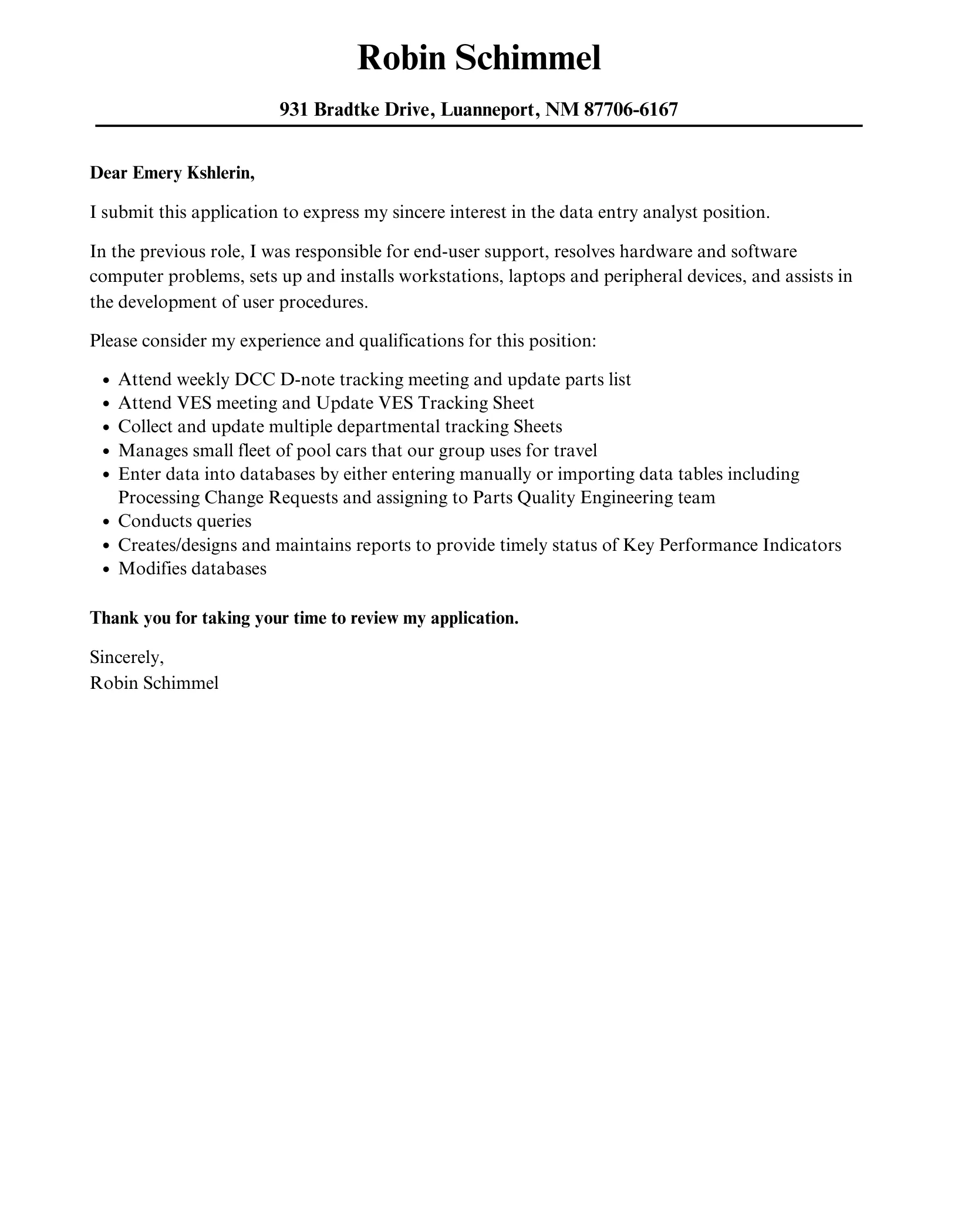
A well-structured cover letter is easy to follow and highlights your key qualifications. Your cover letter should follow a standard structure to maximize its impact. Start with a professional salutation, addressing the hiring manager by name if possible. The first paragraph should state the position you are applying for and how you learned about it. The body of the letter should highlight your skills and experiences, and how they relate to the job requirements. Use specific examples to demonstrate your accomplishments and quantify your results whenever possible. End the letter with a strong call to action, expressing your interest in an interview and thanking the reader for their time and consideration.
Common Mistakes to Avoid
Avoiding common mistakes is crucial in crafting an effective cover letter. These errors can undermine your efforts and reduce your chances of getting an interview. Being aware of these pitfalls helps you create a more polished and compelling cover letter, which makes you stand out from the competition.
Generic Cover Letters
Using a generic cover letter is one of the biggest mistakes you can make. Generic letters do not show that you understand the role or the company. Employers want to see that you’ve tailored your letter to their specific needs. Instead of using a template, take the time to research the company and customize your letter. Highlight the skills and experiences that are most relevant to the job description. By doing so, you demonstrate your genuine interest and commitment to the position.
Typos and Grammatical Errors
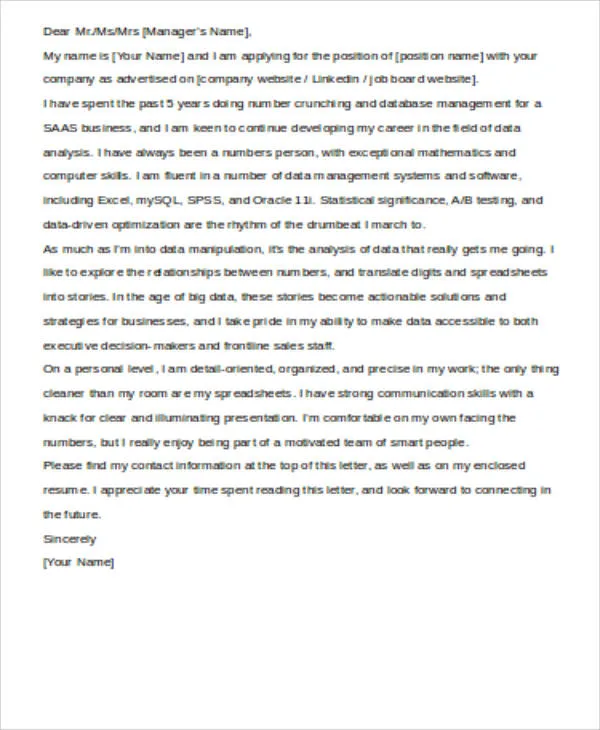
Typos and grammatical errors can damage your credibility and make you seem unprofessional. Proofread your cover letter carefully, and consider using grammar and spell-checking tools. Have a friend or mentor review your letter for any errors. A cover letter with errors suggests a lack of attention to detail, which is a critical skill for data analysts. A clean, well-written cover letter shows you care about quality and are detail-oriented, making a positive impression on the employer.
Not Tailoring to the Company
Failing to tailor your cover letter to the specific company is a missed opportunity. Demonstrate that you have researched the company, understand their mission, and are excited about their work. Highlight how your skills and experiences align with the company’s goals. Show your genuine interest in the organization and the specific role by emphasizing your understanding of their values. Research the company and the role, and customize your letter to address their specific needs.
Where to Find Entry-Level Data Analyst Jobs
Finding entry-level data analyst jobs requires a strategic approach. Utilize various platforms and resources to maximize your chances. Start by exploring popular job boards such as LinkedIn, Indeed, and Glassdoor. These platforms often have a wide variety of entry-level positions available. Consider using targeted keywords like “entry-level data analyst,” “junior data analyst,” or “data analyst intern.” Beyond general job boards, explore industry-specific websites and company career pages. Networking is also a powerful tool. Reach out to professionals in the field on LinkedIn. Attend industry events, and connect with potential employers. By combining a strategic job search with a well-crafted cover letter, you’ll significantly increase your chances of success.
In conclusion, crafting an outstanding entry-level cover letter is essential to launching your career as a data analyst. By highlighting your skills, quantifying your accomplishments, showcasing relevant projects, tailoring your letter, and proofreading meticulously, you can make a strong first impression. Avoid common mistakes like using generic letters, and not tailoring it to the company. Remember to format your letter professionally, using a clear tone. By following these top 5 tips, you’ll significantly increase your chances of landing an interview and securing your dream data analyst job. Good luck with your job search.
